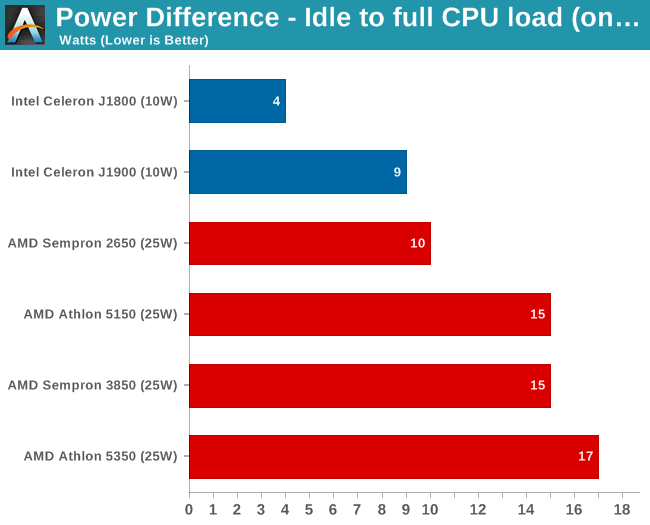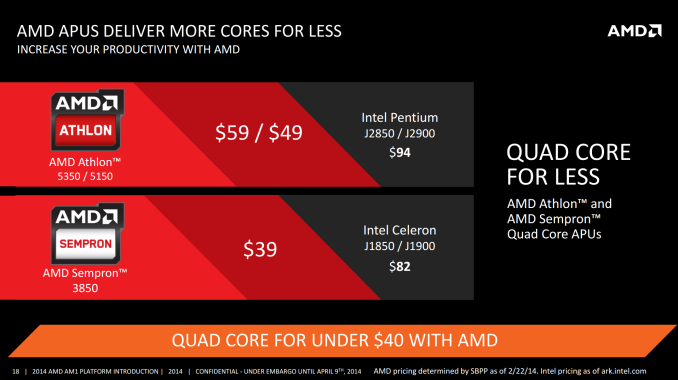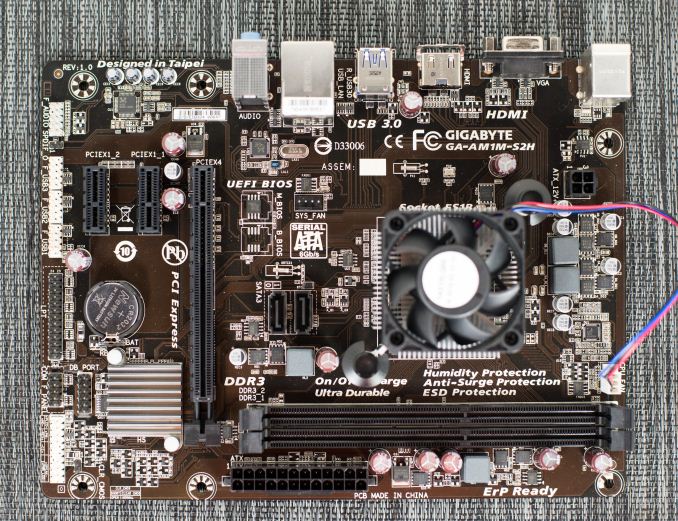AMD AM1 Kabini Part 2: Athlon 5350/5150 and Sempron 3850/2650 Tested
by Ian Cutress on May 29, 2014 2:00 PM ESTThe Competition
Because AMD is the first x86 CPU manufacturer to move their tablet focused processors into the socketed market along with low-cost motherboards, Intel has no direct comparative product. We have to look to their Bay Trail-D SoC range which loses that upgradable functionality. Competition between AMD and Intel on this front is a tit-for-tat operation, with each company focusing on their different strengths. AMD’s integrated IGP aims to be more powerful than the equivalent Intel along with support for DDR3-1600 memory, as well as cheaper overall, however Intel can boast dual channel memory and a lower power output.
With all these differences between Kabini and Bay Trail, including price, power and cores/threads, it is hard to find Intel parts that accurately match each other. AMD has put the following in front of reviewers to provide a guide:
AMD consider the Athlon 5350/5150 parts (quad core, 2.05 GHz and 1.6 GHz) in line with the Intel Pentium J2850/J2900, and the Sempron 3850 with the J1850/J1900. For this Part 2 we were able to obtain full Celeron J1800 (dual core) and Celeron J1900 (quad core) Bay Trail-D parts for testing. Even though AMD puts the Athlon 5350 in the path of the J2900, the J2900 is primarily an OEM solution used by Acer. A single J2900 motherboard appeared on Newegg a week after we had packed up testing.
In fact, I think the 5350 vs the J1900 is a better fit:
| AMD Athlon 5350 vs. Intel Celeron J1900 | ||||
| Athlon 5350 | Celeron J1900 | |||
| CPU Architecture | Jaguar | Silvermont | ||
| CPU Cores | 4 | 4 | ||
| CPU Frequency | 2.05 GHz | 2.0 GHz / 2.4 GHz Turbo | ||
| GPU Cores | 128 SPs | 6 EUs | ||
| GPU Frequency | 600 MHz | 688 MHz | ||
| Memory Channels | Single | Dual | ||
| Memory Frequency | 1600 MHz | 1333 MHz | ||
| L2 Cache | 2 MB | 2 MB | ||
| TDP | 25 W | 10 W | ||
| Price | $59 | $82 | ||
Also we can now directly compare pricing. Take for example the two of the motherboards we had for this review, one J1900 and the other AM1 while equipping the system with an Athlon 5350:
GIGABYTE J1900N-D3V: $87 (Newegg)
GIGABYTE AM1M-S2H: $35 (Newegg)
AMD Athlon 5350: $65 (Newegg)
Totaling up the AMD components gives $100 vs $87 from Newegg, or £65 vs. £66 on Amazon UK, on the extreme high end of a Kabini AM1 setup. Pricing is also influenced slightly by quoting the boxed version of the APU, rather than the OEM pricing that AMD likes to quote.
Our test setup is a follows:
| Test Setup | |
| CPU | AMD Athlon 5350, Quad Core, 2.05 GHz |
| AMD Athlon 5150, Quad Core, 1.60 GHz | |
| AMD Sempron 3850, Quad Core, 1.30 GHz | |
| AMD Sempron 2650, Dual Core, 1.45 GHz | |
| Motherboard | GIGABYTE AM1M-S2H |
| Memory | 2x4GB DDR3-1600 9-10-10 |
| SSD | OCZ Vertex 3 |
| Power Supply | OCZ 1250W ZX Series |
| Graphics | Integrated |
| Graphics Drivers | 14.3 Beta |
Note that for our benchmark results we are also taking data from previous reviews done at AnandTech, including some of the higher powered mainstream systems. Over time we have added benchmarks (such as SYSmark 2014) which are lacking some of the mid-range data.
Power Consumption: Idle to 100% CPU Load (on IGP)

Because of the difference in TDP, the AMD APUs here use more energy, although all four comfortably use less than the 25W TDP. The dual core especially only registered a 10W difference from idle to a full CPU load.













87 Comments
View All Comments
Silver47 - Thursday, May 29, 2014 - link
They are in the graphs, what are you smoking?Novaguy - Thursday, May 29, 2014 - link
I think using a weaker card for the dgpu would also have been interesting. Maybe something like an r7 270, 7750 or 7770.Also, what about Mantle benchmarks?
Novaguy - Thursday, May 29, 2014 - link
I meant r7 250, not 270... can't seem to edit via mobile.V900 - Friday, May 30, 2014 - link
No, no Mantle benchmarks... It's useless, and only serves to clutter the article.Hardly anybody cared about Mantle when it was announced... And now that we know the next version of Direct X is coming, the only people that care the slightest, are a handful of AMD fanbois.
silverblue - Friday, May 30, 2014 - link
You're entitled to your opinion. Let's look at it this way - DirectX 12 won't be here for another 18 months. Also, Mantle has been shown to perform better than AMD's own implementation of DX11 (and sometimes faster than NV's as well) and also helps with lower performing CPUs.The following link only shows the one game, but it should be enough to highlight the potential benefit of Mantle on a comparatively weak architecture such as Jaguar:
http://www.pcper.com/reviews/Graphics-Cards/AMD-Ma...
If you didn't need to upgrade your CPU to play the latest and greatest, I think you'd care, too.
formulav8 - Friday, May 30, 2014 - link
If Mantle was from NVidia or Intel you would be a bigger stooge than anyone AMD.Gauner - Thursday, May 29, 2014 - link
I think it would be far more useful for this weak systems to have a different set of game tests.No one will buy one of those to play tomb raider or bioshock but I'm guessing some people would consider buying one if you could play for example league of legends or dota2 at minimum and 720/1080p.
I understand it would mean an extra effort but right now the gaming tests don't really tell anything useful nor do they add useful information to other reviews by having an extra comparison.
Just taking into account steam games(since they are the easier ones to get data about) in the top 5 most played games daily you always have: dota2, CS:GO and TF2. Those 3 games used to run(poorly, 800x600, low detail, 20-30fps) in the old Intel GMA4500M so in my opinion they have a lot of people potentially interested in them and would run well enough in low power systems to give a useful comparison between chips.
res057 - Thursday, May 29, 2014 - link
Tests with high end games and cpu intensive tasks for processors such as these is like Car and Driver putting a Prius through quarter-mile test and comparing the results with a Corvette. Pointless.Gauner - Friday, May 30, 2014 - link
I can understand the logic behind CPU intensive tasks, even if you wont use this kind of CPUs to compress video with x264 you can watch the results and get a realistic estimation on the performance difference because the test is the same for both weak CPUs and high end CPUs.Problem with the gaming tests is that the comparison is with settings completely different from the high end tests so no parallelism there and with a set of games that no one would think to play in weak systems so there is no useful info given.
I cant look at the results and say "since tomb raider at 1280x1024 with low graphics ran at 20fps I guess league of legends will run at 1080p with medium graphics and 35fps", there are too many different points to make a comparison(AAA engine vs engine designed for low power computers, different resolution, completely different poly count and texture sizes, ...).
takeship - Friday, May 30, 2014 - link
I'm curious why no comparison with the old E-450/E-2000 Jaguar chips. Not so much for the CPU performance, but for the GPU improvements going to GCN.